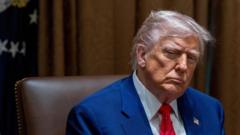This article dives deep into the implications of Trump's tariff plans and the precarious position of U.S. trade relations with allies and adversaries.
Trump's Trade Strategy: Assessing Progress Amid Tariff Uncertainty

Trump's Trade Strategy: Assessing Progress Amid Tariff Uncertainty
After a week of turbulent trade decisions, we analyze whether President Trump's goals are within reach.
In the wake of an intense week for U.S. trade policy, President Donald Trump’s ambitious tariff plan seems to have hit a snag. Initially designed to impose sweeping tariffs that would alter the global economic landscape, Trump has temporarily suspended higher tariffs for 90 days on most countries, redirecting focus towards an escalating trade conflict with China. As the countdown begins, we take stock of five critical objectives Trump aims to achieve and assess their current status.
1) **Securing Better Trade Deals**
Trump’s stance is clear: “For decades, our country has been looted, pillaged, and plundered…” His initial proposal set a baseline 10% tariff across multiple countries, resulting in worldwide economic apprehension. Yet, Treasury Secretary Scott Bessent proudly noted that over 75 global leaders have approached Trump to negotiate. Although no comprehensive list of countries has been disclosed, talks with South Korea and Japan indicate some momentum. The takeaway: The 90-day timeframe offers trading partners a desperate chance to negotiate, hinting at potential gains for Trump.
2) **Revitalizing American Industry**
“I will bring jobs and factories back into our country,” Trump has claimed, asserting tariffs would bolster domestic manufacturing. However, the uncertainty surrounding fluctuating tariffs may hinder substantial investments. Business leaders are likely to postpone new production commitments until the tariff landscape stabilizes, causing potential delays in reshoring efforts. The takeaway: An unpredictable tariff environment may compel companies to remain cautious rather than proactive.
3) **Confronting China**
"I respect President Xi, but they’re taking tremendous advantage of us," Trump remarked. After recent tariff adjustments, several aides quickly reasserted that China represents the real trade adversary. Trump’s willingness to confront China aligns with past rhetoric, although it risks alienating crucial allies needed in a significant tussle with a global economic power. The takeaway: The ramifications of a trade conflict with China pose substantial risks, demanding careful navigation to mitigate diplomatic fallout.
4) **Generating Revenue**
“I will use trillions of dollars to reduce taxes and pay down the national debt,” Trump touted during his campaign. The nonpartisan Tax Foundation estimated that a 10% universal tariff might yield $2 trillion in revenue over the next decade. That projection could fund tax cuts amidst a $5 trillion deficit attributed to new tax plans. The takeaway: If Trump adheres to current tariffs, revenue gains may materialize, but they are contingent on the resultant economic landscape.
5) **Lowering Consumer Prices**
Ultimately, Trump’s vision is for increased domestic production leading to lower consumer costs, declaring it "the golden age of America." While energy prices have dipped post-announcement, expert consensus suggests new tariffs will likely elevate consumer prices. In fact, a 10% tariff could cost American households an average of $1,253 in its first year. The takeaway: Rising costs could jeopardize Trump's support among the electorate, particularly low-income families impacted the most.
As Trump navigates this multifaceted trade dilemma, the paths forward remain fraught with uncertainty, sacrifice, and potential rewards—defining moments that will likely shape America's trade landscape for years to come.






















